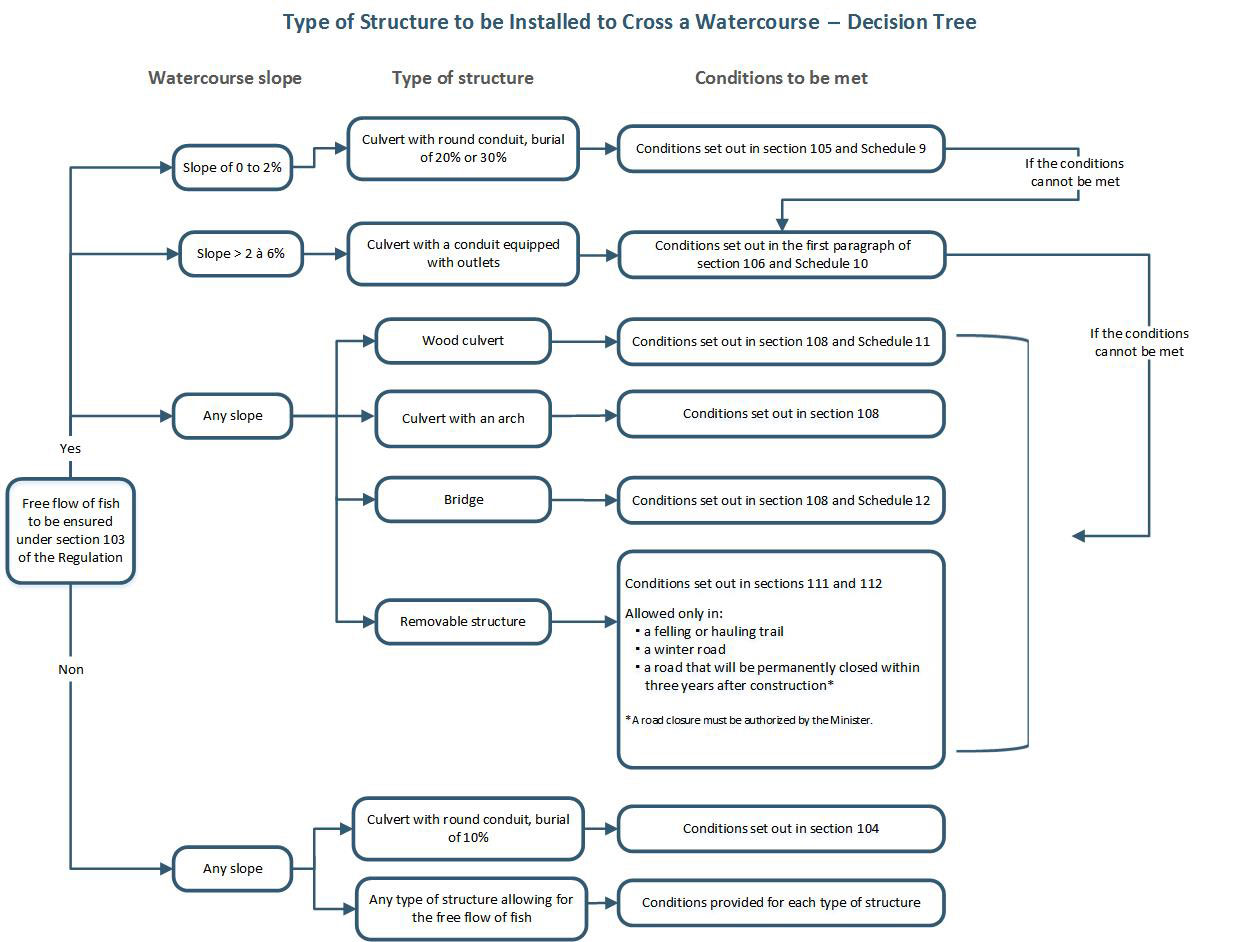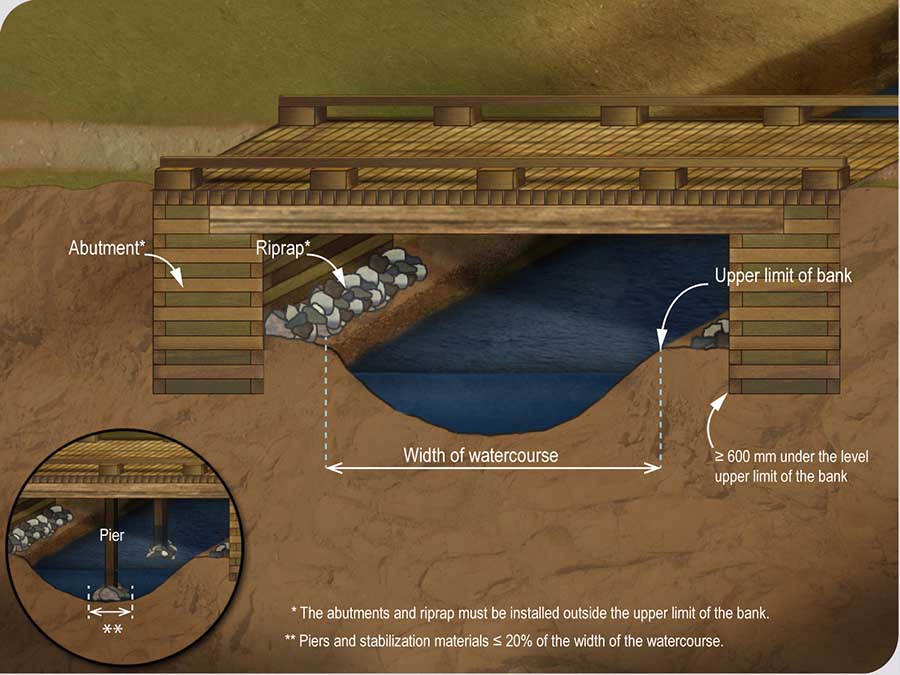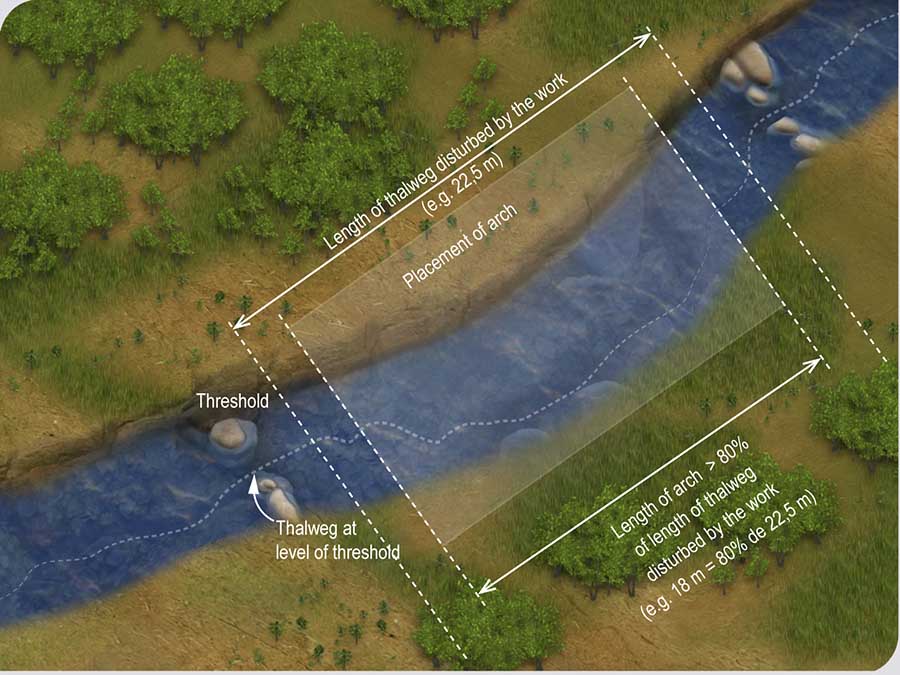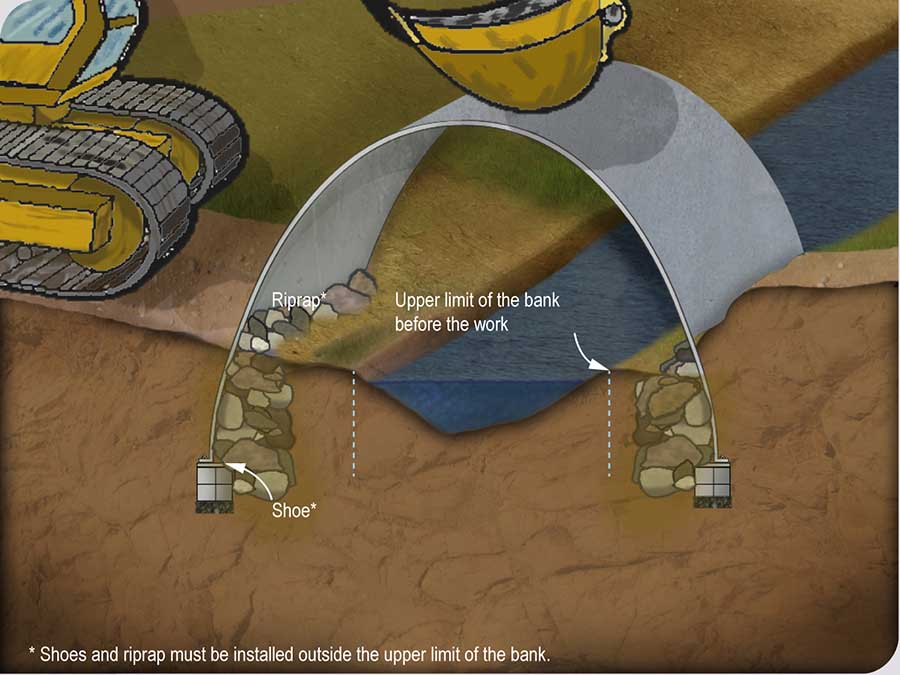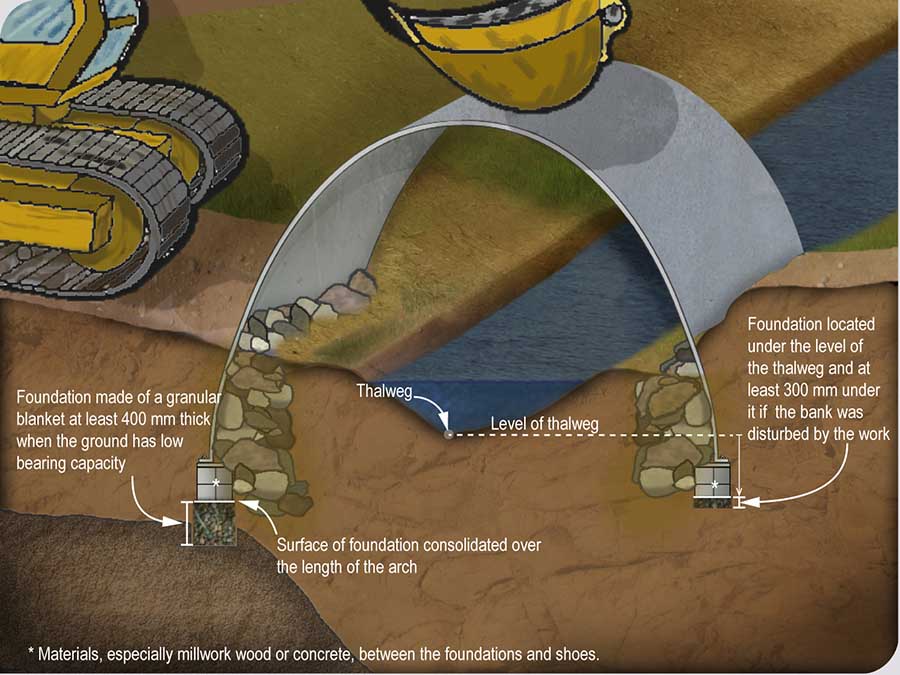Chapter V – Roads, sandpits and forest infrastructures
Division III – Bridge, culverts, removable structures and rudimentary structures
§5. Special provisions applicable to bridges or culverts with an arch
Section 108

1
Additional information
The decision tree below can be used to decide on the type of structure that must be installed to cross a watercourse.
The construction, improvement or repair of a bridge must meet the following conditions:
(1) the bridge must not have the effect of reducing the width of the watercourse, measured from the upper limit of the banks; 
2
Objectives
- To ensure the lifespan of a road, bridge or culvert
- To ensure the free flow of water
- To ensure the free flow of fish
- To preserve the integrity of an aquatic, wetland or riparian environment
Additional information
The materials used to stabilize the abutments form an integral part of the bridge as defined in section 2. These materials must therefore not have the effect of reducing the width of the watercourse, measured at the level of the upper limit of the banks.
How is the width of a watercourse measured?
The width of a watercourse is calculated using the average of at least four representative measurements of the natural watercourse taken upstream and downstream of the crossing site. If there are signs of narrowing or widening, the section in question (e.g. area disturbed by a beaver dam) must be excluded. The width is measured at the level of the upper limit of the banks. The method used to identify the upper limit is shown in the definition of “bank” or “shore”.
When a bridge built, improved or repaired before the coming into force of this Regulation is improved or repaired, the width of the watercourse is determined using the measurements made at the upper limit of the banks created during that work if it reduces the width of natural watercourse and if the materials used to consolidate the banks are stable. If the banks are unstable at the crossing point, the width of the watercourse is determined using the method set out in the preceding paragraph.
(2) the abutments of a bridge must be installed outside the upper limit of the bank and be buried at least 600 mm under the level of the upper limit of the bank. 
3
Objectives
- To ensure the lifespan of a road, bridge or culvert
- To limit the structure’s encroachment into an aquatic environment
Figure 108A Characteristics of a bridge installation in relation to the upper limit of the banks
Subparagraph (1) of the first paragraph does not apply to a bridge including 1 or a number of piers. The piers and materials used for their stabilization must not have the effect of reducing the width of the watercourse by more than 20%, measured from the upper limit of the banks. 
4
Objectives
- To ensure the lifespan of a road, bridge or culvert
- To ensure the free flow of water
- To ensure the free flow of fish
- To limit the structure’s encroachment into an aquatic environment
Figure 108A Characteristics of a bridge installation in relation to the upper limit of the banks
Additional information
The materials used to stabilize piers form an integral part of the bridge as defined in section 2. The piers and materials must not reduce the width of the watercourse by more than 20%, measured at the upper limit of the banks.
How is the width of a watercourse measured?
The width of a watercourse is calculated using the average of at least four representative measurements of the natural watercourse taken upstream and downstream of the crossing site. If there are signs of narrowing or widening, the section in question (e.g. area disturbed by a beaver dam) must be excluded. The width is measured at the level of the upper limit of the banks. The method used to identify the upper limit is shown in the definition of “bank” or “shore”.
When a bridge built, improved or repaired before the coming into force of this Regulation is improved or repaired, the width of the watercourse is determined using the measurements made at the upper limit of the banks created during that work if it reduces the width of natural watercourse and if the materials used to consolidate the banks are stable. If the banks are unstable at the crossing point, the width of the watercourse is determined using the method set out in the preceding paragraph.
The construction, improvement or repair of a culvert with an arch must meet the following conditions:
(1) the work area must be dried; 
5
Objectives
- To avoid carrying sediment into an aquatic, wetland or riparian environment
- To ensure the lifespan of a road, bridge or culvert
(2) the length of an arch must be not more than 24 m; 
6
Objectives
- To ensure the free flow of fish
- To minimize straightening of a watercourse
(3) an arch must be installed in the natural axis of the watercourse, in a relatively straight section whose banks are well defined. The length of an arch must be greater than 80% of the length of the thalweg of the section of the watercourse that will be disrupted by the work; 
7
Objectives
- To avoid the scouring of a watercourse
- To minimize straightening of a watercourse
Additional information
The limit on the length of the arch compared to the length of the thalweg measured before the work is intended to limit straightening of the stretch of watercourse affected by the work and to maintain its natural balance. The fact of limiting straightening also helps avoid increasing the slope and hence the speed of the current. A faster current may cause erosion and degradation of the bed and banks of the watercourse.
Figure 108B Minimum length of the arch compared to the length of the thalweg disturbed by the work
(4) an arch must not have the effect of reducing the width of the watercourse, measured from the upper limit of the banks; 
8
Objectives
- To maintain a flow level and water level in the culvert that are sufficient to ensure the free flow of fish
- To limit the structure’s encroachment into an aquatic environment
- To avoid scouring of a watercourse
- To ensure the lifespan of a road, bridge or culvert
Additional information
How is the width of a watercourse measured?
The width of a watercourse is calculated using the average of at least four representative measurements of the natural watercourse taken upstream and downstream of the crossing site. If there are signs of narrowing or widening, the section in question (e.g. area disturbed by a beaver dam) must be excluded. The width is measured at the level of the upper limit of the banks. The method used to identify the upper limit is shown in the definition of “bank”.
(5) the walls of a wooden culvert or the shoes of an arch other than wooden must be installed outside the upper limit of the bank; 
9
Objective
- To ensure the lifespan of a road, bridge or culvert
Figure 108C Characteristics of an arch installation in relation to the upper limit of the banks
(6) the parts of each shoe of an arch other than wooden must be installed so as to form a continuous shoe and be attached over the whole length of the arch. Where there are materials, in particular in millwork wood or concrete, between the foundations and the shoes of an arch other than wooden, they must be attached to the shoes and cover their whole length; 
10
Objective
- To ensure the lifespan of a road, bridge or culvert
Additional information
The materials located between the foundations and the shoes of an arch other than a wooden arch are intended to create a sufficiently large working space to reconstitute the bed of the watercourse and stabilize the internal base of the arch with a riprap.
Figure 108D Characteristics of the foundations of an arch
(7) the walls of a wooden culvert or the shoes of an arch other than wooden must be installed on level foundations consolidated over the whole length of the arch. The foundations must be below the thalweg. Where the banks are disturbed by the work, the foundations must be at least 300 mm under the thalweg. If rock is present before reaching that depth, the walls or shoes must be anchored to the rock. For ground with weak bearing capacity, the walls or shoes must be installed on foundations made of a granular blanket at least 400 mm thick; 
11
Objective
- To ensure the lifespan of a road, bridge or culvert
Figure 108D Characteristics of the foundations of an arch
(8) the walls, shoes, foundations and materials placed between the shoes and the foundations of an arch must be adequately protected with riprap that is flood resistant in order to prevent scouring. The riprap of an arch must not encroach on the bed of the reconstituted watercourse; 
12
Objective
- To avoid scouring of a watercourse
- To limit the structure’s encroachment into an aquatic environment
- To ensure the lifespan of a road, bridge or culvert
- To ensure the free flow of fish
Figure 108D Characteristics of the foundations of an arch
(9) a section of watercourse disrupted by the construction, improvement or repair work of a culvert with an arch must be reconstituted by meeting the following conditions:
- the reconstituted section of the watercourse must have the same width as that measured from the upper limit of the banks before the work;

13
Objectives
- To avoid scouring of a watercourse
- To ensure the lifespan of a road, bridge or culvert
- To maintain a flow level and water level in the culvert that are sufficient to ensure the free flow of fish
Additional information
How is the width of a watercourse measured?
The width of a watercourse is calculated using the average of at least four representative measurements of the natural watercourse taken upstream and downstream of the crossing site. If there are signs of narrowing or widening, the section in question (e.g. area disturbed by a beaver dam) must be excluded. The width is measured at the level of the upper limit of the banks. The method used to identify the upper limit is shown in the definition of “bank”.
- the bed must be reconstituted with heterogeneous materials similar to that constituting the bed of the natural watercourse to which big rocks must be added;

14
Objectives
- To avoid scouring of a watercourse
- To ensure the free flow of fish
- To maintain a flow level and water level in the culvert that are sufficient to ensure the free flow of fish
Additional information
The materials used to stabilize the watercourse bed must be able to support the water flow speed so that they are not eroded and carried away by the current. A variety of materials similar to those that make up the natural bed of the watercourse should be used (rounded materials with a variety of particle sizes), and they should be arranged so as to overlap one another. This ensures that the reconstituted bed is watertight, and that water cannot filter through the materials. The addition of large stones (roughly 1.5 times the size of the largest stones in the natural watercourse), scattered across the bed, will improve stability and prevent scouring. The presence of large stones also helps to create a variety of flow conditions and also to create shelter for fish. When the stones are installed, it is important to ensure that they are nested and anchored in the underlying substrate, by partially burying them.
- wood debris, organic matter and topsoil may not be used to reconstitute the bed. The materials that may be used must include enough fine particles to seal the reconstituted bed. Where materials from the bed excavated during the work are used to reconstitute the bed, only surface materials may be used;

15
Objectives
- To avoid carrying sediment into an aquatic, wetland or riparian environment
- To avoid scouring of a watercourse
- To ensure the lifespan of a road, bridge or culvert
Additional information
Wood debris, organic matter and topsoil may not be used to reconstitute the bed inside the arch, because they may introduce suspended matter into the watercourse and hinder the stability of the bed. The materials used must be of different sizes (with a particle size composition similar to that of the watercourse) and be laid out so as to overlap one another. This ensures that the reconstituted bed is watertight, and that
water cannot infiltrate through the materials. Infiltration may hinder the stability of the bed by causing scouring. It may also have the effect of reducing the water level in the arch, where the water must be deep enough to allow the biggest fish to swim past the structure. The water must be at least 20 cm deep, or of equal depth to the water in the section of the natural watercourse downstream of the arch. - a canal must be laid out in the reconstituted section of the watercourse in order to concentrate the water during the low flow period;

16
Objective
- To ensure the free flow of fish
Additional information
A low-flow channel similar to the one found in the natural watercourse must be laid out in the reconstituted section of the watercourse in order to concentrate the water during the low flow period. The bottom of the channel must correspond to the thalweg of the watercourse bed.
- the water of the watercourse must be gradually re-circulated in the work area to allow the adjustment and imbrication of the materials of the reconstituted bed and thus ensure the imperviousness of the bed;

17
Objective
- To avoid scouring of a watercourse
Additional information
The devices that were used to dry out the work area temporarily must be removed gradually, starting with the one located upstream, so that the materials making up the reconstituted bed can adjust and overlap one another.
- in a salmonid watercourse, the devices used to temporarily dry the work area must be removed gradually so that 2/3 of the flow of the watercourse is re-circulated in the work area;
- in a salmonid watercourse, the arch, riprap, bed and banks located in the work area must be cleaned to remove fine particles deposited on the surface. The cleaning must take place before opening the cofferdam located downstream from the culvert with an arch;
- in a salmonid watercourse, roily water must be pumped outside the work area to vegetation areas located more than 20 m from the watercourse. The 20-m distance is measured from the limit that separates the stand from the watercourse or, in the presence of a riparian ecotone, from the limit of the ecotone farthest from the environment to be protected. The water must be clear before opening the cofferdam located downstream from the culvert with an arch and before removing all the devices used to temporarily dry the work area.

18
Objectives
- To avoid carrying sediment into an aquatic, wetland or riparian environment
- To avoid scouring of a watercourse
Explanations
In a salmonid watercourse, the arch, riprap, bed and banks located in the work area must be cleaned to remove fine particles deposited on the surface. Not only does this limit the input of fine sediment into the watercourse, but the washing of the surface of the reconstituted bed helps make it more watertight by adjusting and overlapping the materials of which it is composed.
A commonly used technique is to clean the surface of a reconstituted watercourse directly, using a fire hose, working upstream to downstream. The washing water is directed towards a low point of the work area and pumped into vegetation located more than 20 m from the watercourse or, where there is a riparian ecotone, from the limit of the ecotone located furthest from the environment to be protected. The water must be clear before opening the coffer dam located downstream from the culvert with an arch and before removing all the devices used to dry out the work area temporarily.
Special care is needed when removing the devices used to dry out the work area temporarily in a salmonid watercourse. The devices must be removed gradually, starting with the one located upstream, until less than two-thirds of the watercourse flow has been restored in the reconstituted bed. During this operation, which is also designed to clean the bed and make it more watertight, the roily water must be pumped outside the work area into vegetation areas located more than 20 m from the watercourse. The hose used to pump the water must be equipped with a strainer to prevent fish from being sucked in.
In addition to the conditions provided for in the third paragraph applicable to all culverts with an arch, a wooden culvert must also meet the conditions provided for in Schedule 11 during its construction, improvement or repair. 
19
Objective
- To ensure the lifespan of a road, bridge or culvert
Explanations
A wooden culvert is a culvert with a wooden arch. The provisions of the third, fourth and fifth paragraphs of this section (from the fifth to the twentieth flag) concerning culverts with an arch therefore also apply to wooden culverts. In addition, this type of culvert must meet the conditions provided for in Schedule 11.
This section does not apply to a person who, in accordance with section 41 of the Sustainable Forest Development Act  (chapter A-18.1), was authorized by the Minister to build a bridge or a culvert with an arch meeting other conditions or to a person who has obtained such an authorization under a forestry permit or by a contract or an agreement entered into under the Act.
(chapter A-18.1), was authorized by the Minister to build a bridge or a culvert with an arch meeting other conditions or to a person who has obtained such an authorization under a forestry permit or by a contract or an agreement entered into under the Act. 
20
Objective
- To protect forest resources during specific road, bridge or culvert construction or improvement work
Explanations
A person authorized by the Minister in accordance with section 41 of the Sustainable Forest Development Act  (chapter A-18.1) may construct a bridge or culvert that meets conditions other than those indicated in this section.
(chapter A-18.1) may construct a bridge or culvert that meets conditions other than those indicated in this section.
The Minister may grant authorization and specify the conditions that must be met when carrying out the work.
Additional information
A person wishing to obtain authorization for this must complete the following steps:
- Fill out the LADTF Section 41 Authorization Application Form
 ;
; - Have it signed by a forest engineer;
- Forward it to the management unit in the region
 (in French only) where the project is located.
(in French only) where the project is located.
The application must describe the situation that justifies completion of the work in accordance with standards different from those enacted in the Regulation. It must also propose replacement measures that will be implemented to achieve the objectives of the regulatory standards from which a departure is requested. Where the proposed replacement standards fall within the approval framework, authorization may be granted along with conditions that must be met when carrying out the work.

